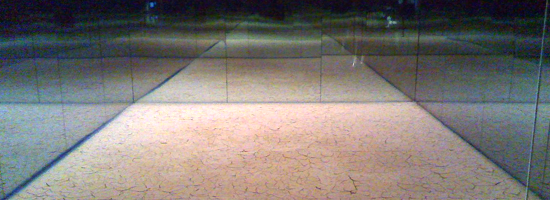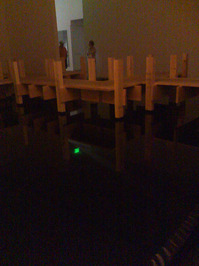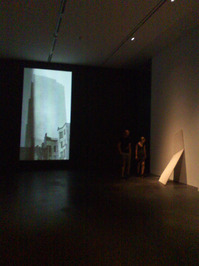Museum of Contemporary Art Denver:
Another Victory Over the Sun
June 9, 2011 - August 21, 2011
 Victory
over the Sun
is the title of a 1913 Russian opera. Another Victory over the Sun is
the name of the summer exhibition at the Museum of Contemporary Art in
Denver.
Victory
over the Sun
is the title of a 1913 Russian opera. Another Victory over the Sun is
the name of the summer exhibition at the Museum of Contemporary Art in
Denver.
One work, the short video by Miguel Calderon, called Los Pasos del Enemigo, The Steps of the Enemy, I've seen several times. It was scary, wariness evoking every time, except one.
First, you have be aware there's no sunlight coming into the museum, so you can't really find the entrance to the video room. You can hear sounds of a wild cat before you find the entrance through the heavy black curtain into this gallery.
I fumbled around in the pretty-near-blackness and stand in pitch darkness. I don't know what's in this space with me. There's a burst of guttural roars - a big cat of some kind - and then you're surprised by the flash of yellow eyes and menacing teeth, and a sporadic variety of more growls.
On the day before the show opened, I heard that sound of tape ripping off a roll. They were finishing the work of blocking out all the sunlight. You've seen movies of people being duck taped. It's a scary sound in a dark room with a panther growling at you. The steps of the enemy ... when it's dark you can see those steps.
The next visit I was by myself, and realized I have very poor depth perception in the hearing sense. I knew what was going to happen but still I felt not so confident. The piece is very effective at letting us know our place is nature is very complicated.
Another time, I read the curatorial card that explains the piece and it refers to a Spanish expression: 'gato encerrado,' which literally means 'locked up cat'. I learn it is also the Spanish equivalent of: 'something's fishy' or 'I smell a rat.' And I start to think of how the video was made - probably at a zoo - with a locked up cat. I'm being scared, effectively, by a big cat in a cage. And my enemies, I'm not sure where they are. I am in the dark about them.
The only time I was not creeped out, scared, and off balance, I went into this gallery with a bunch of people, who all happened to be my family. We can bump into each other and its funny not scary. One laughs and someone makes a joke that we've probably heard before.
It made me realize why all those Ancestral Puebloans who used to live at Mesa Verde vanished - completely vanished from the Mesa - about the same time. They wanted to stick together.
If you'd like to read or hear more about this exhibition on UnsafeArt.com, please click on Personal Victory.
June 9, 2011 - August 21, 2011
 Victory
over the Sun
is the title of a 1913 Russian opera. Another Victory over the Sun is
the name of the summer exhibition at the Museum of Contemporary Art in
Denver.
Victory
over the Sun
is the title of a 1913 Russian opera. Another Victory over the Sun is
the name of the summer exhibition at the Museum of Contemporary Art in
Denver. One work, the short video by Miguel Calderon, called Los Pasos del Enemigo, The Steps of the Enemy, I've seen several times. It was scary, wariness evoking every time, except one.
First, you have be aware there's no sunlight coming into the museum, so you can't really find the entrance to the video room. You can hear sounds of a wild cat before you find the entrance through the heavy black curtain into this gallery.
I fumbled around in the pretty-near-blackness and stand in pitch darkness. I don't know what's in this space with me. There's a burst of guttural roars - a big cat of some kind - and then you're surprised by the flash of yellow eyes and menacing teeth, and a sporadic variety of more growls.
On the day before the show opened, I heard that sound of tape ripping off a roll. They were finishing the work of blocking out all the sunlight. You've seen movies of people being duck taped. It's a scary sound in a dark room with a panther growling at you. The steps of the enemy ... when it's dark you can see those steps.
The next visit I was by myself, and realized I have very poor depth perception in the hearing sense. I knew what was going to happen but still I felt not so confident. The piece is very effective at letting us know our place is nature is very complicated.
Another time, I read the curatorial card that explains the piece and it refers to a Spanish expression: 'gato encerrado,' which literally means 'locked up cat'. I learn it is also the Spanish equivalent of: 'something's fishy' or 'I smell a rat.' And I start to think of how the video was made - probably at a zoo - with a locked up cat. I'm being scared, effectively, by a big cat in a cage. And my enemies, I'm not sure where they are. I am in the dark about them.
The only time I was not creeped out, scared, and off balance, I went into this gallery with a bunch of people, who all happened to be my family. We can bump into each other and its funny not scary. One laughs and someone makes a joke that we've probably heard before.
It made me realize why all those Ancestral Puebloans who used to live at Mesa Verde vanished - completely vanished from the Mesa - about the same time. They wanted to stick together.
If you'd like to read or hear more about this exhibition on UnsafeArt.com, please click on Personal Victory.
 Learning to step into the shade was my first victory over the sun. Is this show about how man's ingenuity can beat nature's unpleasantness? Or do we need to know the art history themes attributed to the first Victory Over the Sun to get this show?
Learning to step into the shade was my first victory over the sun. Is this show about how man's ingenuity can beat nature's unpleasantness? Or do we need to know the art history themes attributed to the first Victory Over the Sun to get this show?
